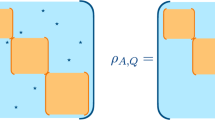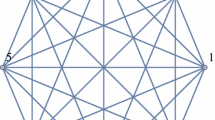Abstract
In this paper, we investigate the behavior of quantum entanglement in the process of unitary evolution in constructive models of multicomponent quantum systems. Symmetry groups of quantum systems that admit the occurrence of geometric structures associated with quantum entanglement are described. Algorithms for dynamic simulation of quantum entanglement are based on methods of computer algebra and computational group theory. Some examples of practical computations are presented.
Similar content being viewed by others
Notes
Any linear representation of a finite group over a field of characteristic zero is unitary.
Provided that we neglect empirically insignificant elements of the traditional formalism, e.g., infinities of various kinds.
The metaphor “church of the larger Hilbert space” (J.A. Smolin) characterizes the belief that any mixed state actually stems from a more fundamental pure state of a larger system.
An antihomomorphism is a map of groups that reverses the order of group multiplication: \(\mu \left( {ab} \right) = \mu \left( b \right)\mu \left( a \right)\).
Except for two-dimensional Hilbert spaces.
Any unitary matrix can be represented as an exponent of a Hermitian matrix, and the corresponding formula \(U = {{e}^{{{\mathbf{i}}H}}}\) can be interpreted as a unitary evolution in one time step generated by the Hamiltonian H.
Geometric structures that occur in the Hilbert space depend significantly on the quantum state. That is why, e.g., in [15], only quantum states constrained to ensure the fulfillment of the holographic principle [23] were considered; according to this principle, the information (entropy) about a physical system within a three-dimensional region is concentrated at the two-dimensional boundary of this region.
REFERENCES
Kornyak, V.V., Quantum models based on finite groups, J. Phys.: Conf. Ser., 2018, vol. 965.
Kornyak, V.V., Modeling quantum behavior in the framework of permutation groups, EPJ Web Conf., 2018, vol. 173.
Banks, T., Finite deformations of quantum mechanics, 2020.
Kornyak, V.V., Mathematical modeling of finite quantum systems, Lect. Notes Comput. Sci., Adam, G., Eds., 2012, vol. 7125.
’t Hooft, G., The cellular automaton interpretation of quantum mechanics, Fundam. Theor. Phys., 2016, vol. 185.
Collins, T., On Jordan’s theorem for complex linear groups, J. Group Theor., 2007, vol. 10, no. 4, pp. 411–423.
Kirillov, A.A., Elementy teorii predstavlenii (Elements of Representation Theory), Moscow: Nauka, 1978.
Meldrum, J.D.P., Wreath Products of Groups and Semigroups, New York: Wiley, 1995.
James, G.D. and Kerber, A., The representation theory of the symmetric group, Encycl. Math. Its Appl., 1981, vol. 16.
Kaloujnine, L. and Krasner, M., Produit complet des groupes de permutations et probléme d’extension de groupes I, Acta Sci. Math., 1950, vol. 13, pp. 208–230; II, Acta Sci. Math., 1951, vol. 14, pp. 39–66; III, Acta Sci. Math., 1951, vol. 14, pp. 69–82.
Rényi, A., On measures of information and entropy, Proc. 4th Berkeley Symp. Mathematics, Statistics, and Probability, 1960, pp. 547–561.
Gleason, A.M., Measures on the closed subspaces of a Hilbert space, Indiana Univ. Math. J., 1957, vol. 6, pp. 885–893.
Van Raamsdonk, M., Building up spacetime from quantum entanglement, Gen. Relativ. Grav., 2010, vol. 42, pp. 2323–2329.
Maldacena, J. and Susskind, L., Cool horizons for entangled black holes, Fortsch. Phys., 2013, vol. 61, no. 9, pp. 781–811.
Cao, C., Carroll, S.M., and Michalakis, S., Space from Hilbert space: Recovering geometry from bulk entanglement, Phys. Rev. D, 2017, vol. 95.
Kornyak, V.V., Splitting permutation representations of finite groups by polynomial algebra methods, Lect. Notes Comput. Sci., Gerdt, V.P., , Eds., 2018, vol. 11077, pp. 304–318.
Kornyak, V.V., An algorithm for decomposing representations of finite groups using invariant projections, J. Math. Sci., 2019, vol. 240, pp. 651–664.
Kornyak, V.V., A new algorithm for irreducible decomposition of representations of finite groups, J. Phys.: Conf. Ser., 2019, vol. 1194.
Kornyak, V.V., An algorithm for computing invariant projectors in representations of wreath products, Lect. Notes Comput. Sci., England, M., et al., Eds., 2019, vol. 11661, pp. 300–314.
Kornyak, V.V., Computation of irreducible decompositions of permutation representations of wreath products of finite groups, Comput. Math. Math. Phys., 2020, vol. 60, no. 1, p. 90–101.
Kornyak, V.V., Discrete dynamical systems with symmetries: Computer analysis, Program. Comput. Software, 2008, vol. 34, pp. 84–94.
Borg, I. and Groenen, P.J.F., Modern Multidimensional Scaling: Theory and Applications, New York: Springer, 2005, 2nd ed.
’t Hooft, G., Dimensional reduction in quantum gravity, 1993.
Author information
Authors and Affiliations
Corresponding author
Additional information
Translated by Yu. Kornienko
Rights and permissions
About this article
Cite this article
Kornyak, V.V. Dynamic Simulation of Quantum Entanglement in Finite Quantum Mechanics: A Computer Algebra Approach. Program Comput Soft 47, 124–132 (2021). https://doi.org/10.1134/S0361768821020067
Received:
Revised:
Accepted:
Published:
Issue Date:
DOI: https://doi.org/10.1134/S0361768821020067




